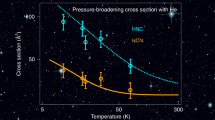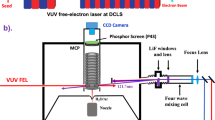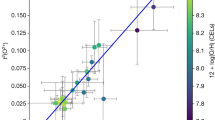Abstract
THE radiation from hydrogen atoms which is observed at radio and millimetre wavelengths due to atomic transitions between levels of high quantum number n cannot be accounted for without accurate calculations of the population densities of all the levels1,2. In order to interpret the observed intensities3, and to deduce physical parameters such as temperatures and abundances, accurate calculations of level populations are needed. In gaseous nebulae the physical processes which may populate and depopulate a quantum level are radiative capture and cascade, collisional ionization and three-body recombination, collisional transitions (n→n′) induced by electrons and protons, and radiative transitions induced by the free–free continuum within the nebula. Calculations have been made over a large range of temperatures and densities and for all n. The results should be much more accurate than any available previously.
This is a preview of subscription content, access via your institution
Access options
Subscribe to this journal
Receive 51 print issues and online access
$199.00 per year
only $3.90 per issue
Buy this article
- Purchase on Springer Link
- Instant access to full article PDF
Prices may be subject to local taxes which are calculated during checkout
Similar content being viewed by others
References
Kardashev, N. S., Sov. Astron. AJ, 3, 813 (1959).
Terzian, Y., Interstellar Ionized Hydrogen (Benjamin, New York, 1968).
Goldberg, L., Astrophys. J., 144, 1225 (1966).
Dyson, J. E., Astrophys. J., 155, 4 (1969).
Seaton, M. J., Mon. Not. Roy. Astron. Soc., 127, 177 (1964).
Burgess, A., and Summers, H. P., Astrophys. J., 157, 1007 (1969).
Seaton, M. J., Proc. Phys. Soc., 79, 1105 (1962).
Burgess, A., and Percival, I. C., Adv. Atomic Molecular Phys., 4, 109 (1968).
Baker, J. G., and Menzel, D. H., Astrophys. J., 88, 52 (1938).
Seaton, M. J., Mon. Not. Roy. Astron. Soc., 119, 81 (1959).
Menzel, D. H., and Pekeris, C. L., Mon. Not. Roy. Astron. Soc., 96, 77 (1935).
Menzel, D. H., Nature, 218, 756 (1968).
Hoang-Binh, D., Astrophys. Lett., 2, 231 (1968).
Sejnowski, T. J., and Hjellming, R. M., Astrophys. J., 156, 915 (1969).
Author information
Authors and Affiliations
Rights and permissions
About this article
Cite this article
BROCKLEHURST, M. Physical Sciences: Level Populations of Excited States of Hydrogen in Gaseous Nebulae. Nature 225, 618–619 (1970). https://doi.org/10.1038/225618a0
Received:
Issue Date:
DOI: https://doi.org/10.1038/225618a0
Comments
By submitting a comment you agree to abide by our Terms and Community Guidelines. If you find something abusive or that does not comply with our terms or guidelines please flag it as inappropriate.



